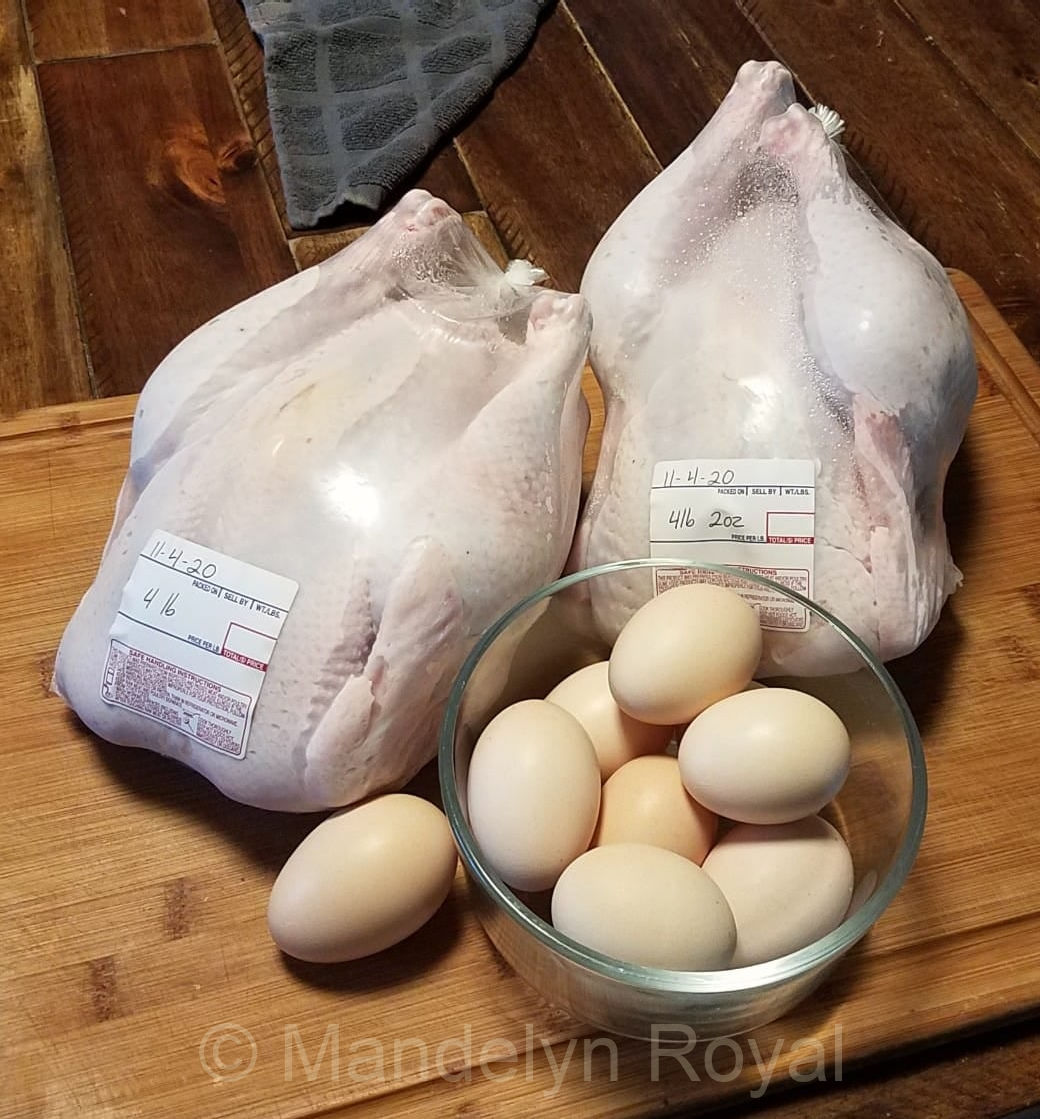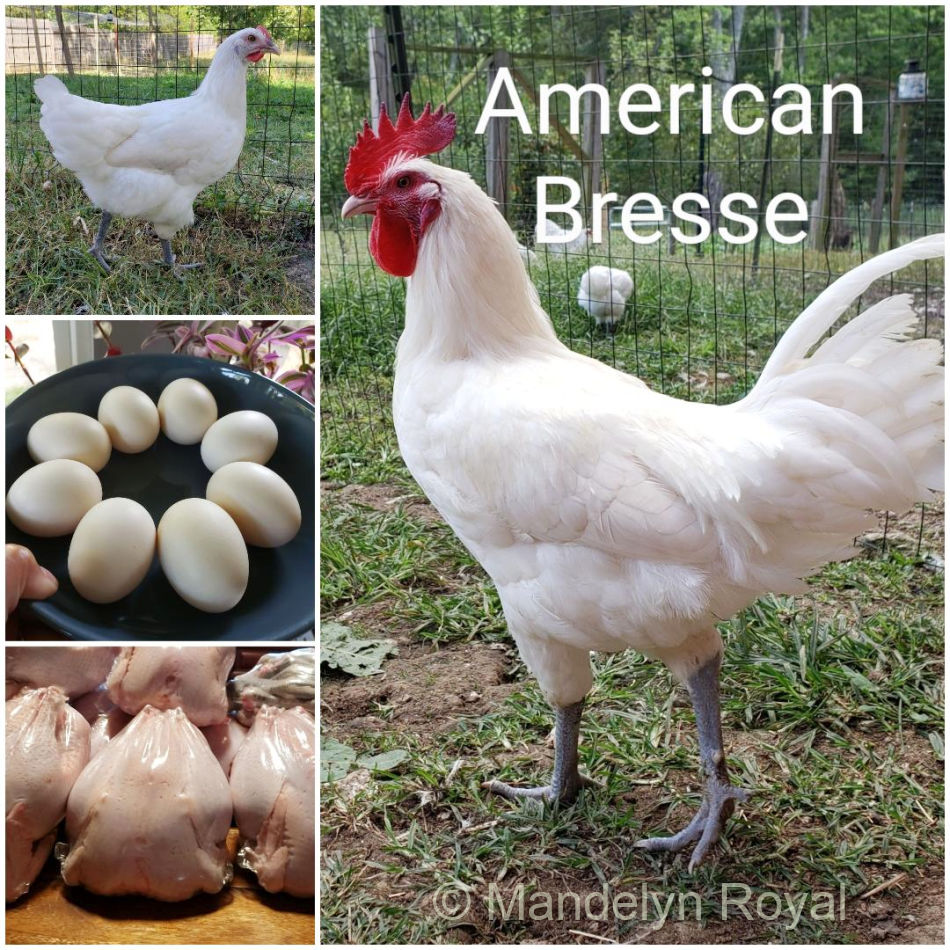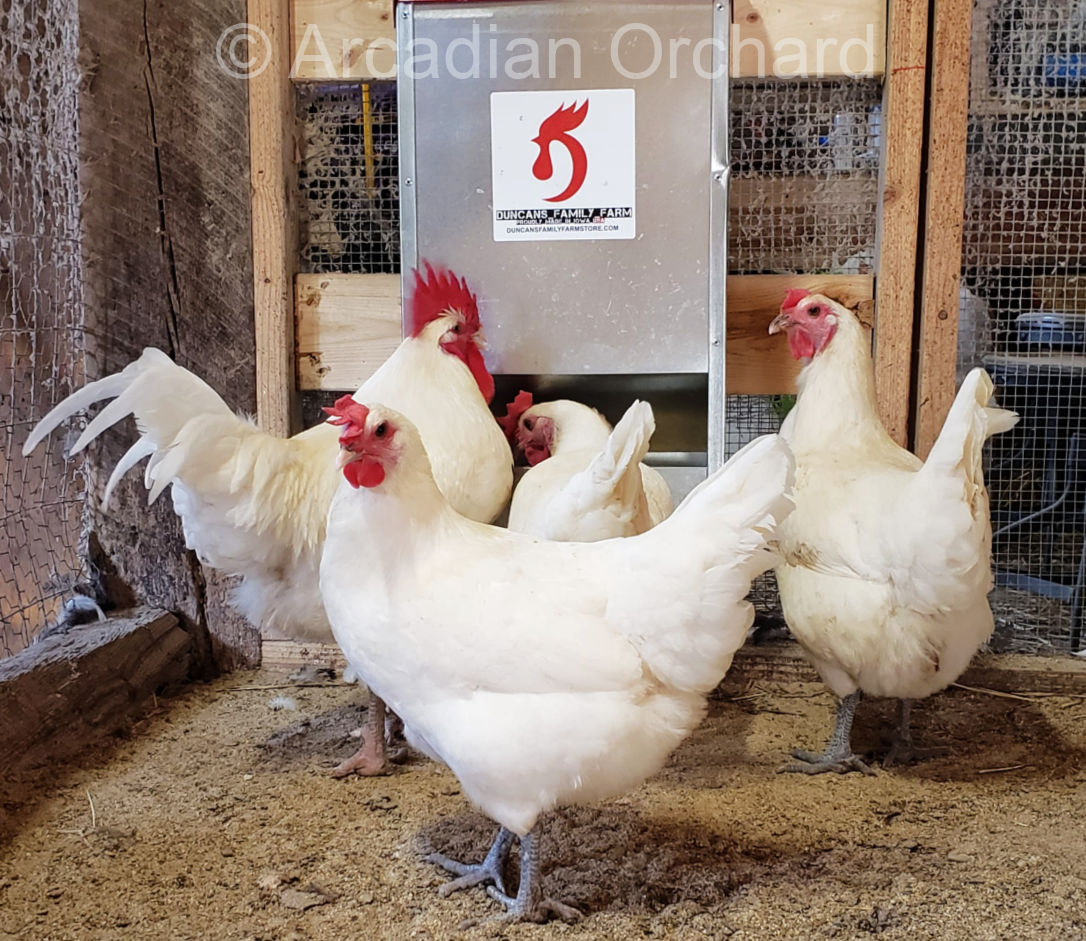The Process of Selective Breeding
The Process of Selective Breeding: Decision-making for breed excellence in American Bresse Chickens.
Selective breeding embodies all the breeding choices one makes with the intent of improving the genetics and the phenotype of the offspring over the parent chickens. There is always a goal in mind. It might be as loose as a vision in your head, or as concrete as an actual Standard of Perfection - a document listing all the agreed-upon characteristics that the excellent American Bresse chicken should possess and embody.
The following is a guest post by Mandelyn Royal, breeder of American Bresse and fearless leader of the charge to organize an American Bresse Club in North America, outlining some breeding criteria and various processes she uses to improve her own American Bresse chickens.
The Process of Selective Breeding
By Mandelyn Royal
The process of selective breeding, essentially, is building up better birds than what you started with through selection for the desired traits. It's a long haul effort that takes many seasons, aiming at a goal of the breed standard, table qualities or ideally both. We all came into this at different starting phases, based on the breeding work that had been done with the birds before we got them.
It's a matter of sorting out expressed traits, comparing each bird to their peers and finding the ones that are closest to the desired result. Then, you have to sort through them again to find which bird goes best with the birds of the opposite gender.
The Process of Selective Breeding:
Initial Bird Selections
I usually pick my males first, since they throw themselves forward and cover the most breeding opportunity. A hen will lay her allotted number of eggs but it's the male who can cover several females or even rotate through several pens of female sets over the course of the season.
Once I've picked a male, I list out his good and bad points.
When I go through the females, I look for them to have the same good points but to also be better than him on his worse points, or for her to be showing the complete opposite of what he shows, in the hopes of bringing balance to the offspring.
Breeding is about the offspring. The adults used may not be the greatest example for their variety but if you find the right male/female pairing, the offspring will show the effort and be improved. It's the step forward in progress that we're all looking for. Sometimes followed by 2 steps back the next season. Or another step forward. Win some, lose some, since we're dealing with nature and living beings.
It's important to learn the line you have, to see their traits, to see what they produce, to see the differences in the results from one female to another when the same male is used. Getting into the thick of it and growing out a lot of birds will get you through the steep learning curve and it will get you the experience to keep moving forward with progress. It's important to keep track of who you're hatching from and what their results are.
Once you have the offspring, stalk their growth. Find your faster growers by weighing them or feeling on them often. I structured our grow space to force me to handle them often, as I shuffle them through the grow spaces. From the incubator to the 1st brooder is the very first sort/feel. Then it's every 2 weeks through a series of brooders that are bigger than the last one they were in, until 8 weeks old when I split them by gender. The biggest male or 2 at that time stays with the females. The rest of the males go to pasture and I won't sort them again until 16 weeks.
The more you get your hands on them, the more you learn about their structure, growth and fleshing, and the better you get at comparing them to each other.
Selective Breeding Competition?
You're not competing with anyone else, it's your birds against your own birds and it's them against the breed standard and desired results, at least until this variety starts finding themselves at chicken shows. THEN that's where competition starts between the breeders. 🤣 They're a long way from that though.
The Process of Selective Breeding:
Hatch From (Too) Many Hens
The reason I love American Bresse chickens so much is because we can eat
the mistakes and they're a great meal. Better than average, when it comes to
home grown chicken of the dual purpose persuasion. Just that fact in our situation,
where this is the only chicken we eat all year long, means that I can
intentionally hatch from too many hens.
Hatching from too many hens speeds up the process of selective breeding by offering up more birds to choose from, and a better education in learning what the line throws when spread across several individuals. I can then find which girls throw a better result with a particular male, and those are the girls who stay on much longer term.
Within a given season, I go into it looking for 175-ish total males, for
dinner. Hopefully from that, I can find the best ones to carry over for the
next season. If we weren't eating them,
I wouldn't have the space or the reason to hatch and grow that many. Without
that quantity, I wouldn't have the breeding choices on hand to select from.
Once you start to really see the tiny differences between the birds, the things that make each one a little different from another, then it becomes a puzzle. One cockerel has these traits that are good and these traits that are not so great, while another cockerel has a different result in how his expressed traits turned out. Both grew well, both are a good weight, but the combs and tail sets are different. That's where the girl choices come into play. Do you have the girls on hand to help out either male? Sometimes the "tie breaker" is not between the males themselves, but between the girls and who is more compatible with a particular male.
For example, if one boy has a lower tail set than another, and the girls all have a higher tail set, then it's gotta be the lower tailed male, to increase the odds of getting lower tailed offspring. Otherwise that tail set will keep creeping higher and higher until you have a bunch of squirrels running around.
A pale blue leg color to a pale blue leg color will make legs paler still. One part of the breeding equation needs to have darker legs, in order to get some offspring that have darker legs. Dark legs to dark legs will make more dark legs. It's about finding balance while in search of improvements, without letting go of traits in order to focus on a particular trait. Figuring out which birds do it best with each other is the goal.
Once you find the best pairings for breeding in the flock, birds whose offspring show the most improvement, consistency and balance, hatch all you can from them.
The Process of Selective Breeding:
Grow Outs
We do our grow outs on a stagger, so that they're well housed and the feed bill doesn't get crazy all at once. Usually I hatch for 7 months straight with 2-5 weeks in between hatches, to reflect our grow space and keep on a schedule. Aiming for 25-50 chicks within a batch, with the peak during May/June when the pasture is at its best.
By summer, I can see what the earlier results were and I can start eyeballing which females will get paired with dumplings and which ones will winter over for the next season, if they had the hatch results to warrant keeping them. The ones who didn't produce as well get replaced with improved daughters.
Now that we're wrapping up our 5th full season of this, I'm seeing improved growth, better fleshing, better breed specific traits on a more consistent level and the flaws that were in the first group we brought in are becoming non existent.
 Two processed American Bresse chickens and eggs. Photo: Mandelyn Royal.
Two processed American Bresse chickens and eggs. Photo: Mandelyn Royal.The Process of Selective Breeding:
"Flubs" Might Be a Thing...
I did have a flub where we brought in new birds. They proved to be a set back, but by keeping them organized I was able to move them right back out and into the freezer.
I hatched from them, saw the results and realized it wasn't worth it. It would have been another 5 years to sort them out and get them better than how I found them; they did my existing birds no favors when I crossed the lines.
That time I didn't get the "magic" bird that would accelerate some things but I had been hopeful. That's not to say I would never find that one game changer bird by crossing lines, though it's possible. That just wasn't the group with which to do it.
The Process of Selective Breeding:
End of Season Sort
This time of year - September - we're at the point where I have some 5 pens of birds at various ages to sort through. The older the group, the fewer of them there are. As you learn the line and how they grow, you can start seeing when to sort for the things you know to cull for. It will vary from line to line, it depends solely on how that particular group of birds mature, and some need more time than others to show what they're made of.
Don't Rush the Process of Selective Breeding
You don't want to "put all your eggs in one basket" by selecting too soon from birds you don't know very well. You don't want to cull down to a single male before he's a year old, since that comb might fall over or he might up and die or his next molt will change his feather hue or texture or some other change. Always keep a spare or know someone with the same line that you can get a spare from. Losing the main male can tank an entire season.
Remember that even though they're table ready around 16-20 weeks old and the girls are laying shortly after that, they are by no means mature for a chicken. A pullet doesn't become a hen until she's a year old. They'll change further still until 2 years old. You don't want to become short sighted with their productivity, definitely keep an eye on how they continue to age and mature. The best chicks that a hen will make happens after she's 1.5 years old, anything congenital that would have killed her off would have happened by then.
You don't want to miss out on those prime chicks, but instead work the flock towards acquiring those "it" girls over time. Sort and cull as you go, do test hatches to see what they throw, leading up to when you have the core group of healthy, vigorous, well built, productive and MATURE hens. Once you find the male who brings out their best, that's when you hatch a bunch of them and really see the improvements. It takes time and patience!
In the poultry world, it's not uncommon for the best offspring to be coming from just a single pair or trio. Keep that in mind. You might start with a flock of 12 and there might be 8 duds in it. Breed better than them from the offspring who turned out better.
+++
For More Info about Mandelyn Royal
Facebook: Arcadian Orchard
American Bresse Club webpage: American Bresse Breed Club
Breeder Info: https://www.ambresse.com/american-bresse-chicken-breeders.html#royal
- Home
- Selective Breeding
- Process of Selective Breeding
Minor edits and formatting by Karen Patry, Ambresse.com
Overheard...
Tasty Recipe! "I processed my first batch of Bresse... Today I roasted one according (somewhat) to the recipe posted on Ambresse. It was delicious! Tender, moist and succulent... So happy I chose this breed!" (B.E., MN, 12/11/2024).
Success: "I can't believe all the inquiries we get through your website. And it's been a great resource to send people to who are interested in the (AB) breed" (Utangard Farm, NH, 5/5/2025).
Informational: "Your site has the first accurate information about American Bresse chickens that I have seen in English. Thanks for your diligent work" (L. Wooton, NC, 12/17/2024).
Translate This Page
Traduire Cette Page
Traduzca Esta Pagina

News
American Bresse Breed Club web pages can be found under the Breed Club tab on the navigation bar. Any changes in Club status will be posted here!

Photo credit: Mandelyn Royal.


